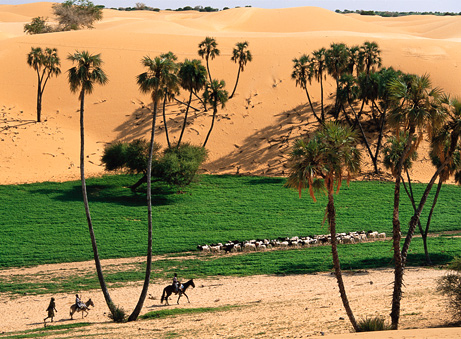
[see: [EW 2009 Aug] The Greening of the Sahara.]
Sahara Desert Greening Due to Climate Change?
James Owen
http://news.nationalgeographic.com/news/2009/07/090731-green-sahara.html
July 31, 2009
Desertification, drought, and despair—that's what global warming has in store for much of Africa. Or so we hear.
Emerging evidence is painting a very different scenario, one in which rising temperatures could benefit millions of Africans in the driest parts of the continent.
Scientists are now seeing signals that the Sahara desert and surrounding regions are greening due to increasing rainfall.
If sustained, these rains could revitalize drought-ravaged regions, reclaiming them for farming communities.
This desert-shrinking trend is supported by climate models, which predict a return to conditions that turned the Sahara into a lush savanna some 12,000 years ago.
Green Shoots
The green shoots of recovery are showing up on satellite images of regions including the Sahel, a semi-desert zone bordering the Sahara to the south that stretches some 2,400 miles (3,860 kilometers).
Images taken between 1982 and 2002 revealed extensive regreening throughout the Sahel, according to a new study in the journal Biogeosciences.
The study suggests huge increases in vegetation in areas including central Chad and western Sudan.
The transition may be occurring because hotter air has more capacity to hold moisture, which in turn creates more rain, said Martin Claussen of the Max Planck Institute for Meteorology in Hamburg, Germany, who was not involved in the new study.
"The water-holding capacity of the air is the main driving force," Claussen said.
Not a Single Scorpion
While satellite images can't distinguish temporary plants like
grasses that come and go with the rains, ground surveys suggest recent
vegetation change is firmly rooted.
In the eastern Sahara area of southwestern Egypt and northern Sudan, new
trees—such as acacias—are flourishing, according to Stefan Kröpelin, a climate
scientist at the University of Cologne's Africa Research Unit in Germany.
"Shrubs are coming up and growing into big shrubs. This is completely different from having a bit more tiny grass," said Kröpelin, who has studied the region for two decades.
In 2008 Kröpelin—not involved in the new satellite research—visited Western Sahara, a disputed territory controlled by Morocco.
"The nomads there told me there was never as much rainfall as in the past few years," Kröpelin said. "They have never seen so much grazing land."
"Before, there was not a single scorpion, not a single blade of grass," he said.
"Now you have people grazing their camels in areas which may not have been used for hundreds or even thousands of years. You see birds, ostriches, gazelles coming back, even sorts of amphibians coming back," he said.
"The trend has continued for more than 20 years. It is indisputable."
Uncertain Future
An explosion in plant growth has been predicted by some climate
models.
For instance, in 2005 a team led by Reindert Haarsma of the Royal Netherlands Meteorological Institute in De Bilt, the Netherlands, forecast significantly more future rainfall in the Sahel.
The study in Geophysical Research Letters predicted that rainfall in the July to September wet season would rise by up to two millimeters a day by 2080.
Satellite data shows "that indeed during the last decade, the Sahel is becoming more green," Haarsma said.
Even so, climate scientists don't agree on how future climate change will affect the Sahel: Some studies simulate a decrease in rainfall.
"This issue is still rather uncertain," Haarsma said.
Max Planck's Claussen said North Africa is the area of greatest disagreement among climate change modelers.
Forecasting how global warming will affect the region is complicated by its vast size and the unpredictable influence of high-altitude winds that disperse monsoon rains, Claussen added.
"Half the models follow a wetter trend, and half a drier trend."

Villagers herd goats near windblown sand dunes in the Sahel region of Niger,
North Africa.
Vast swaths of North Africa are getting noticeably lusher due to warming
temperatures, new satellite images show, suggesting a possible boon for people
living in the driest part of the continent.
Photograph by Pascal Maitre/NGS